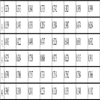- Home
- About Journals
-
Information for Authors/ReviewersEditorial Policies
Publication Fee
Publication Cycle - Process Flowchart
Online Manuscript Submission and Tracking System
Publishing Ethics and Rectitude
Authorship
Author Benefits
Reviewer Guidelines
Guest Editor Guidelines
Peer Review Workflow
Quick Track Option
Copyediting Services
Bentham Open Membership
Bentham Open Advisory Board
Archiving Policies
Fabricating and Stating False Information
Post Publication Discussions and Corrections
Editorial Management
Advertise With Us
Funding Agencies
Rate List
Kudos
General FAQs
Special Fee Waivers and Discounts
- Contact
- Help
- About Us
- Search

The Open Cybernetics & Systemics Journal
(Discontinued)
ISSN: 1874-110X ― Volume 12, 2018
A Triangular Cloud Model and Cloud Generator Algorithm
Yanbing Gong*, Liangliang Dai, Na Hu
Abstract
Cloud model is a cognitive model which represents the fuzziness and randomness with three digital characteristics, i.e. expectation, entropy and hyper-entropy. The normal cloud model is one of the most important cloud models, which is composed of 2nd-order normal distribution. The normal cloud model is usually expressed in qualitative concept with symmetrical features, and for the concept of fasymmetric only uses the complex combination of cloud model. Therefore, it is more complex in computing and processing in practical application. A new simple cloud model, i.e. triangular cloud model is proposed, and the forward triangular cloud transformation algorithm is presented. Then, a backward triangular cloud transformation algorithm is designed based on the fuzzy discrete expectation. Finally, two simulation examples are given to state the feasibility of the triangular cloud, and the result shows that the new generator algorithm is simple and effective.
Article Information
Identifiers and Pagination:
Year: 2016Volume: 10
First Page: 192
Last Page: 201
Publisher Id: TOCSJ-10-192
DOI: 10.2174/1874110X01610010192
Article History:
Received Date: 14/10/2015Revision Received Date: 27/08/2016
Acceptance Date: 05/09/2016
Electronic publication date: 18/10/2016
Collection year: 2016
open-access license: This is an open access article licensed under the terms of the Creative Commons Attribution-Non-Commercial 4.0 International Public License (CC BY-NC 4.0) (https://creativecommons.org/licenses/by-nc/4.0/legalcode), which permits unrestricted, non-commercial use, distribution and reproduction in any medium, provided the work is properly cited.
* Address correspondence to this author at the Department of Information Management, Hohai University, No. 200 North Jinling Road, Changzhou, China; Tel: +86 519 8123 0713; E-mail: yanbg79@163.com
| Open Peer Review Details | |||
|---|---|---|---|
| Manuscript submitted on 14-10-2015 |
Original Manuscript | A Triangular Cloud Model and Cloud Generator Algorithm | |
1. INTRODUCTION
Knowledge representation has been a bottleneck for years in artificial intelligence. The difficulty is uncertainty hidden in qualitative concepts, in particular, randomness and fuzziness [1D.Y. Li, and Y. Du, Artificial Intelligence with Uncertainty., National Defense Industry Press: Beijing, 2014.]. The mathematic methods for handing uncertainty knowledge mostly are probability theory and fuzzy set theory. Probability theory mainly studies the stochastic phenomena, which can deal with stochastic uncertainties well. The normal distribution can be regarded as approximation of a large number of random phenomena [2Z.K. Wang, Applications of the Probability., Beijing Normal University Press: Beijing, 1995.]. Fuzzy set theory mainly studies the fuzzy phenomena, which mainly use membership degree of the membership function to describe fuzzy events [3L.A. Zadeh, "Fuzzy sets", Inf. Control, vol. 8, pp. 338-353, 1965.
[http://dx.doi.org/10.1016/S0019-9958(65)90241-X] ]. The Gaussian membership function is considered as one of the most suitable membership function for many fuzzy events. Cloud model was proposed based on probability theory and fuzzy sets theory to describe the uncertainty knowledge in 1995 [4D.Y. Li, H.J. Meng, and X.M. Shi, "Membership clouds and membership cloud generators", Int. J. Intell. Syst., vol. 32, pp. 16-21, 1995.]. The normal cloud model uses three digital characteristics to represent the uncertainty transition between quantitative and qualitative descriptions, which will integrate the randomness and the fuzziness in 2nd-order normal distribution in unified way [5D.Y. Li, J.W. Han, and X.M. Shi, "Knowledge repressentation and discovery based on linguistic atoms", Knowl. Base. Syst., vol. 10, pp. 431-440, 1998.
[http://dx.doi.org/10.1016/S0950-7051(98)00038-0] -8G.Y. Wang, C.L. Xu, and D.Y. Li, "Generic normal cloud model", Inf. Sci., vol. 280, pp. 1-15, 2014.
[http://dx.doi.org/10.1016/j.ins.2014.04.051] ].
The normal cloud model uses three digital characteristics (Ex, En, He) to depict the intension of a concept, which just accords with human thought. Expected value Ex is used to show the center position of the normal cloud, whose elements are fully compatible with the uncertainty linguistic concept. The standard variance En is a measure of the granularity scale, which can be used to calculate the membership degree. The hyper-entropy He is a measure of the dispersion on the normal cloud drops, which can also be considered as the entropy of the standard variance En. In order to transform the uncertainty concept of quantitative and qualitative description, Li et al. [1D.Y. Li, and Y. Du, Artificial Intelligence with Uncertainty., National Defense Industry Press: Beijing, 2014.] presented two basic cloud transformation tools, namely forward normal cloud generator (FNCG) and backward normal cloud generator (BNCG). By inputting the number of its characteristics, FNCG produces normal cloud droplets described by the specific concept. BNCG can obtain the qualitative description of 2nd-order normal distribution from a series of quantitative cloud droplets which have been given. The two cloud generators can also provide a way to simulate the human bidirectional cognition process for uncertainty concepts by computer program.
At present, the normal cloud model has been successfully applied in many fields, such as intelligent control [9F.Z. Zhang, Y.Z. Fan, and C.Z. Shen, "Intelligent control based on membership cloud generators", Chin. J. Electron., vol. 20, pp. 89-92, 1999., 10H. Chen, and B. Li, "Approach to uncertain reasoning based on cloud model", J. Chine. Comput. Syst., vol. 32, pp. 2449-2455, 2011.], data mining [11Y. Liu, D.Y. Li, and G.W. Zhang, "Atomized feature in cloud based evolutionary algorithm", Chin. J. Electron., vol. 37, pp. 1651-1658, 2009.-13W.J. Zhang, S.L. Liu, and B. Sun, "A cloud model-based method for the analysis of accelerated life test data", Microelectron. Reliab., vol. 55, pp. 123-128, 2014.
[http://dx.doi.org/10.1016/j.microrel.2014.10.006] ], qualitative evaluation [14H.J. Lu, Y. Wang, and D.Y. Li, "The application of backward cloud in qualitative evaluation", Chine. J. Comp., vol. 26, pp. 1009-1014, 2003., 15Y.Z. Shi, and H.C. Zhou, "Research on monthly flow uncertain reasoning model based on cloud theory", Sci. China, vol. 53, pp. 2408-2413, 2010.
[http://dx.doi.org/10.1007/s11431-010-4048-7] ], image segmentation [16K. Qin, K. Xu, and F.L. Liu, "Image segmentation based on histogram analysis utilizing the cloud model", Comput. Appl. Math., vol. 62, pp. 2824-2833, 2011.
[http://dx.doi.org/10.1016/j.camwa.2011.07.048] , 17T. Wu, and K. Qin, "Image segmentation using cloud model and data field", Pattern Recogn. Artif. Intell., vol. 25, pp. 397-405, 2012. [http://doi:10.16451/j.cnki.issn1003-6059.2012.03.003].], decision making [18X.J. Yang, L.L. Yan, and L. Zeng, "How to handle uncertainties in AHP: the cloud delphi hierarchical analysis", Inf. Sci., vol. 222, pp. 384-404, 2013.
[http://dx.doi.org/10.1016/j.ins.2012.08.019] -21D. Wang, D.B. Zeng, and V.P. Singh, "A multidimension cloud model-based approach for water quality assessment", Environ. Res., vol. 149, pp. 113-121, 2016.
[http://dx.doi.org/10.1016/j.envres.2016.05.012] ], and so on. However, the normal cloud model is usually expressed in qualitative concept with symmetrical features, and for the concept of asymmetry only uses the complex combination of cloud model. In fact, a lot of linguistic variables or qualitative concepts are asymmetric in quantification, for example, the concept “Young” in Fig. (2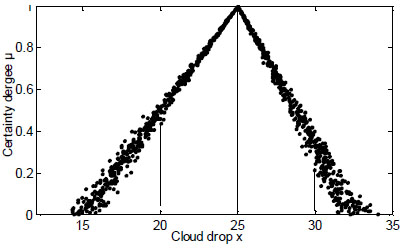 ). Normal cloud model needs complex calculation and requires linguistic concept with symmetry in the practical application. Therefore, a simple triangular cloud model is proposed in this paper. The characteristic of triangular cloud model is that the function has the advantage of simple structure, and can unify qualitative representation of the linguistic concept of symmetry and asymmetry, which is conducive to the practical application of uncertain description and problem solving.
). Normal cloud model needs complex calculation and requires linguistic concept with symmetry in the practical application. Therefore, a simple triangular cloud model is proposed in this paper. The characteristic of triangular cloud model is that the function has the advantage of simple structure, and can unify qualitative representation of the linguistic concept of symmetry and asymmetry, which is conducive to the practical application of uncertain description and problem solving.
The rest of the paper is organized as follows: In Section 2, the concept and generator algorithms of the normal cloud model are introduced. In Section 3, the concepts about triangular cloud model are described. In Section 4, the efficiency of triangular cloud generator algorithms is discussed through two case studies. Finally, Section 5 presents our conclusions and suggestions for future research.
2. THE NORMAL CLOUD MODEL AND CLOUD GENERATOR
Normal cloud model is a cognitive method of transformation between quantitative data and qualitative concepts, which can formalize a concept into three numbers. Considering the uncertainty and objectivity of the membership degree, normal cloud model automatically produces the membership degrees based on probability distribution to interpret the fuzziness of concepts, thereby disclosing the relationship between randomness and fuzziness [1D.Y. Li, and Y. Du, Artificial Intelligence with Uncertainty., National Defense Industry Press: Beijing, 2014., 5D.Y. Li, J.W. Han, and X.M. Shi, "Knowledge repressentation and discovery based on linguistic atoms", Knowl. Base. Syst., vol. 10, pp. 431-440, 1998.
[http://dx.doi.org/10.1016/S0950-7051(98)00038-0] ].
2.1. The Concept of Normal Cloud Model
Definition 1 [1D.Y. Li, and Y. Du, Artificial Intelligence with Uncertainty., National Defense Industry Press: Beijing, 2014.]: Let U be the universe of discourse, and C be a qualitative concept in U. If x ϵ U is a random instantiation of concept C, which satisfies x ~ N(Ex, En'2), En' ~ N(En, He2), so the degree of certainty of x belonging to concept C satisfies
 |
(1) |
then the distribution of x in the universe U is called a normal cloud or a 2nd-order normal cloud.
The key point in Definition 1 is the 2nd-order relationship, i.e. within the two normal random numbers. Specially, if digital characteristic parameter He=0, then the cloud distribution of x on U will become a normal distribution. If digital characteristic parameters He=En=0, then x will be a constant Ex and µ(x)≡1. If digital characteristic parameter He turns larger, the distribution of random variable X will show a heavier tail, which can be used in economic and social researches.
As shown in Fig. (1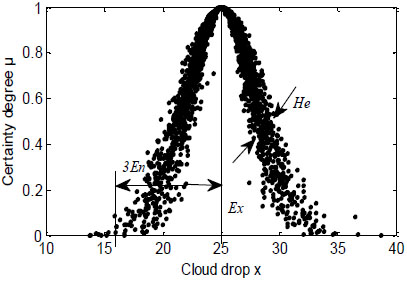 ), different people have different understanding about the concept of “Young”, so it is very different to give a crisp membership degree. However, the normal cloud model can describe this uncertainty concept. Meanwhile, it can also demonstrate the basic certainty of uncertainty.
), different people have different understanding about the concept of “Young”, so it is very different to give a crisp membership degree. However, the normal cloud model can describe this uncertainty concept. Meanwhile, it can also demonstrate the basic certainty of uncertainty.
In normal cloud model, cloud generator, which is a basic tool to realize the transformation between qualitative concepts and quantitative data, is composed of forward cloud generator and backward cloud generator.
2.2. The Forward Normal Cloud Generator
The FNCG is the most commonly used in cloud generator, which is a mechanism for mapping form its qualitative representation to its quantitative representation. By inputting the number of its digital characteristics (Ex, En, He), FNCG produces normal cloud droplets described by the specific concept. The generating algorithm of FNCG (Ex, En, He, n) can be described as follows [1D.Y. Li, and Y. Du, Artificial Intelligence with Uncertainty., National Defense Industry Press: Beijing, 2014., 5D.Y. Li, J.W. Han, and X.M. Shi, "Knowledge repressentation and discovery based on linguistic atoms", Knowl. Base. Syst., vol. 10, pp. 431-440, 1998.
[http://dx.doi.org/10.1016/S0950-7051(98)00038-0] ]:
Algorithm 1: Forward normal cloud generator- FNCG (Ex, En, He, n)
Input: Three parameters, Ex, En, and He, and the number of cloud drops n
Output: n cloud drops and their certainty degrees
Step 1: A normal random number Eni' with expectation of En and a standard deviation of He is generated.
 |
(2) |
Step 2: A normal random number xi with expectation of Ex and a standard deviation of Eni' is generated.
 |
(3) |
Step 3: The certainty degree of xi is calculated as follows:
 |
(4) |
Step 4: Then xi is a cloud drop with the confirmation degree μi expressed as drop (xi ,μi).
Step 5: Repeat the step1 to step4 until the cloud drops generated are sufficient for n.
In Fig. (1 ), this is the result of FNCG (25, 3, 0.5, 2000). It can represent the qualitative concept “Young” or a ratio between 15 and 35 with cloud drops.
), this is the result of FNCG (25, 3, 0.5, 2000). It can represent the qualitative concept “Young” or a ratio between 15 and 35 with cloud drops.
 |
Fig. (1) Describe “Young” by the normal cloud model. |
2.3. The Backward Normal Cloud Generator
The BNCG is an algorithm based on probability statistics theory. It is used to obtain the quantitative description of three digital characteristic parameters. It generates the cloud parameters (Ex, En, He) based on the cloud drops(xi ,μi). Wang et al. [22G.Y. Wang, C.L. Xu, Q.H. Zhang, and X.R. Wang, "A multi-step backward cloud generator algorithm", Springer Berlin Heidelberg: Lecture Notes Comp. Sci, vol. 7413, pp. 313-322, 2012.] constructed a new algorithm of backward cloud based on the theory of probability statistics, which is more precise than the old. The generating algorithm of the one-dimension normal cloud BNCG(xi ,μi) can be described as follows [1D.Y. Li, and Y. Du, Artificial Intelligence with Uncertainty., National Defense Industry Press: Beijing, 2014., 5D.Y. Li, J.W. Han, and X.M. Shi, "Knowledge repressentation and discovery based on linguistic atoms", Knowl. Base. Syst., vol. 10, pp. 431-440, 1998.
[http://dx.doi.org/10.1016/S0950-7051(98)00038-0] ]:
Algorithm 2: Backward normal cloud generator- BNCG (Ex, En, He, n)
Input: n cloud drops and their certainty degrees (xi ,μi)
Output: Three parameters, Ex, En, and He
Step 1: Calculate the mean Ex of cloud drops xi
 |
(5) |
Step 2: Calculate the standard deviation En of cloud drops xi
 |
(6) |
Step 3: For each cloud drop (xi ,μi), calculate the normal random number Eni':
 |
(7) |
Step 4: Then the hyper entropy He can be calculated by the standard deviation of Eni':
 |
(8) |
3. A TRIANGULAR CLOUD MODEL AND CLOUD GENERATOR
Normal cloud model is an effective tool in uncertain transformation between qualitative concepts and their quantitative expressions. However, compared to the normal cloud model, triangular cloud model has extensive existence in everyday life and its own merits to represent numerical concept. For example, the distribution of the concept “Young” between 15 and 35 is not symmetrical. Obviously, the certainty degree is not the same between interval (15, 25) and interval (25, 35). For example, 20 years younger than 30 years, so the certainty degree of 20 is larger than 30. Triangular cloud model can be expressed with symmetry or asymmetry uncertainty linguistic concept.
 |
Fig. (2) Describe “Young” by the triangular cloud model. |
3.1. The Concept of Triangular Cloud Model
Definition 2: Let U be the universe of discourse, and C be a qualitative concept in U. If x ϵ U is a random instantiation of concept C, then the degree of certainty of x belonging to concept C satisfies
 |
(9) |
where Ea' ~ N(Ea, He2) and Ec' ~ N(Ec, He2),then the distribution of x in the universe U is called a triangular cloud model.
From the Definition 3.1, triangular cloud model represents the qualitative concept by four digital characteristics(Ea, Ex, Ec, He). The expected value Ex is the point which is the most suitable to represent the domain of the concept. The left and right spreads Ea and Ec are used to figure the granularity scale of the concept. The hyper-entropy He is used to depict the uncertainty of the concept granularity. Moreover, the simple operation rules of triangular cloud model described below make them feasible in practical applications. Specially, if digital characteristic parameter He=0, then the cloud distribution of x on U will become a triangular distribution. The explicit expressions of fuzziness and uncertainty by parameters(Ea, Ex, Ec, He)make the triangular cloud model easy to understand and compute directly.
Definition 3: Given two triangular clouds C1 and C2, their digital characters are C1(Ea1,Ex1,Ec1,He1)and C2(Ea2,Ex2,Ec2,He2), respectively. The arithmetic operation rules of C1 and C2 can be defined as follows:
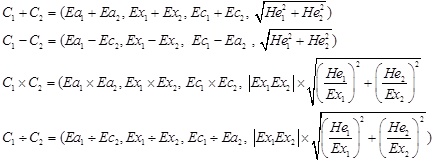 |
(10) |
Similar to the normal cloud, the uncertain concept of C1 and C2 must be in the same universe of discourse such that the triangular cloud operation involved in the algorithm above is meaningful.
3.2. The Forward Triangular Cloud Generator (FTCG)
In order to be able to use computer to calculate the triangular cloud model, it is necessary to research the triangular membership cloud generator algorithm. It generates cloud drops based on the cloud parameters(Ea,Ex,Ec,He). As shown in Fig. (3 ), the generating algorithm of the one-dimension triangular cloud FTCG(Ea,Ex,Ec, He, N) can be described as follows:
), the generating algorithm of the one-dimension triangular cloud FTCG(Ea,Ex,Ec, He, N) can be described as follows:
 |
Fig. (3) A forward triangular cloud generator. |
Algorithm 3: Forward triangular cloud generator- FTCG(Ea,Ex,Ec, He, n)
Input: Three parameters, Ea, Ex, Ec, and He, and the number of cloud drops n
Output: n cloud drops and their certainty degrees
Step 1: Two normal random numbers Ea', Ec' with expectation of Ea, Ec and a standard deviation of He is generated.
 |
(11) |
Step 2: Two uniformly distributed random numbers x1i, x2i are generated.
 |
(12) |
where unit is the random number in interval [0, 1].
Step 3: The certainty degree of xi is calculated as follows:
 |
(13) |
Step 4: Repeat the step1 to step3 until the cloud drops generated are sufficient for n.
The algorithm mainly uses a normal random number and a uniform random number. A random number is the foundation of another random number. It is the compound relationship which is the key of the forward triangular cloud generator algorithm. If He=0, the algorithm step1 always generates a certain value of Ea and Ec, then x has become a triangular membership function. In Fig. (2 ), this is the simulation result of FTCG (15, 25, 32.5, 0.5, 500). It can represent the qualitative language “Young” or a ratio between 15 and 35 with triangular cloud drops.
), this is the simulation result of FTCG (15, 25, 32.5, 0.5, 500). It can represent the qualitative language “Young” or a ratio between 15 and 35 with triangular cloud drops.
3.3. The Backward Triangular Cloud Generator (BTCG)
The BTCG is an algorithm based on fuzzy set theory. It is used to obtain the quantitative description of four digital characteristic parameters. As shown in Fig. (4 ), it generates the triangular cloud parameters (Ea,Ex,Ec,He) based on the cloud drops (xi ,μi).
), it generates the triangular cloud parameters (Ea,Ex,Ec,He) based on the cloud drops (xi ,μi).
 |
Fig. (4) A backward triangular cloud generator. |
Definiton 4 [23B.D. Liu, and Y.K. Liu, "Expected value of fuzzy variable and fuzzy expected value models", IEEE Trans. Fuzzy Syst., vol. 10, pp. 445-450, 2002.
[http://dx.doi.org/10.1109/TFUZZ.2002.800692] ]: Let ξ be a normalized fuzzy variable, the expected value of ξ is defined as:
 |
(14) |
where Cr{A} =0.5(Pos{A}+Nec{A})is the credibility measure.
Let ξ be a normalized discrete fuzzy variable whose possibility distribution function is defined by:
 |
(15) |
Assume that. It follows form (15) that the expected value of ξ is:
 |
(16) |
Then the weights are given by:
 |
(17) |
which µ0=µn+1 for i=1,2,···,n and satisfy the following constraints:
 |
(18) |
If ξ is triangular fuzzy variable(Ea,Ex,Ec), then the expected value of ξ is:
 |
(19) |
The backward triangular cloud generator algorithm is based on the fuzzy mathematical expectation. The generating algorithm of the one-dimension triangular cloud BTCG (xi ,μi) can be described as follows:
Algorithm 4: Backward triangular cloud generator- BTCG (Ea,Ex,Ec, He, n)
Input: n cloud drops and their certainty degrees (xi , μi)
Output: Four parameters, Ea,Ex,Ec and He
Step 1: Sort n cloud drops from small to large, i.ex1 ≤ x2 ≤ ··· ≤ xn.
Step 2: Let:
 |
(20) |
and,
 |
(21) |
Then, calculate the three numerical characters(Ea,Ex,Ec). If
 , then let
, then let
 .
.
Step 3: For each cloud drop (xi , μi), calculate the normal random number Eai', Eci':
 |
(22) |
Step 4: Then the hyper entropy He can be calculated by the standard deviation of Eai', Eci':
 |
(23) |
4. EXPERIMENT ANALYSIS
Example 1: Let n=500, using Matlab programming algorithm can realize the forward triangular cloud generator. For example, let (Ea,Ex,Ec, He)=(0.3, 0.5, 0.8, 0.01), the forward triangular cloud generator FTCG (Ea,Ex,Ec, He, n) is shown in Fig. (5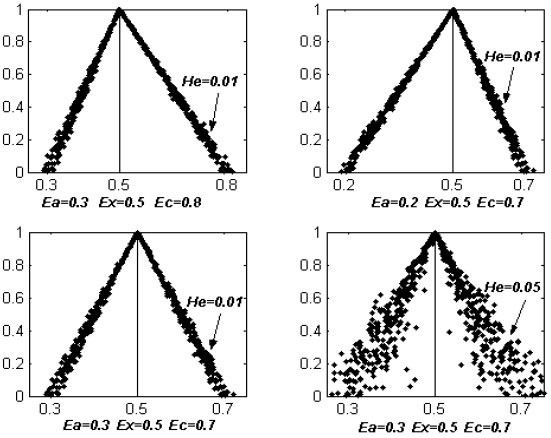 ).
).
The source code is as follows:
Input: (Ea,Ex,Ec, He)=(0.3,0.5,0.8,0.01)
r1=normrnd(Ea, He,[1 500]);
r2=normrnd(Ec, He,[1 500]);
unit=unifrnd(0,1,[1,500]);
x1=r1+(Ex-r1).*unit;
x2= r2+(Ex-r2).*unit;
output: plot(x1,1+(x1-Ex)./(Ex-r1),'k.', x2,1-(x2-Ex)./(r2-Ex),'k.')
Example 2: There is a group of cloud drops (xi, μi), and assume that the cloud drops xi have been sorted, as shown in Table 1.
 |
Fig. (5) Different shapes of triangular membership cloud model. |
We use the backward triangular cloud generator to calculate the four numerical characters (Ea,Ex,Ec, He).
With Step 2, we can get Ea=0.3325, Ec=0.7625, and:
 |
If
 , let
, let
 , we can get:
, we can get:
 |
Then,
Ex=0.4925From Step 3 and step 4, we can get,
 |
Thus, according to this group of cloud drops, the triangle membership cloud model BTCG (Ea,Ex,Ec, He)= BTCG (0.3325,0.4925,0.7625,0.0629), as shown in Fig. (6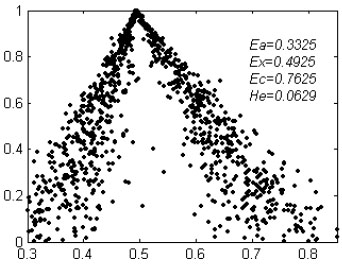 ).
).
 |
Fig. (6) The backward triangular cloud model. |
CONCLUSION
The cloud model is a good tool for the bidirectional cognitive transformation between the qualitative and quantitative description of a concept by using the cloud generator algorithms. In this paper, based on fuzzy triangular membership function, a simpler and practical cloud model - triangular membership cloud model and the cloud generator algorithms are studied. It has very important significance for the promotion of the application of cloud theory and improves and expands of the existing cloud model theory. Compared with the normal cloud model, the triangular cloud model has two advantages. One is that the triangular cloud model can deal with the symmetric and asymmetric qualitative concepts while the normal cloud model can only deal with the symmetric qualitative concept. Another advantage is that the triangular cloud model is simpler than the normal cloud model in computational process, so it is more convenient for practical application.
In this paper, the backward triangular cloud generator algorithm must be given the value of certainty degree in advance. However, in the practical application, we are often only given a group of cloud drops, whose certainty degree was not given. Error analysis of the backward triangular cloud generator algorithm has not been studied theoretically. Therefore, without the value of certainty degree, the implementation of calculating the four parameters of the triangular cloud and error analysis of the backward generator algorithm will be the focus of our future research work.
CONFLICT OF INTEREST
The authors confirm that this article content has no conflict of interest.
ACKNOWLEDGEMENTS
This work was supported in part by the Natural Science Foundation of Jiangsu Province of China (No. BK20130242), the Fundamental Research Funds for the Central Universities (No. 2015B28014), and the Graduate Student Science and Technology Innovation Project of Hohai University Changzhou campus (XZX/ 14B001-07).
REFERENCES
| [1] | D.Y. Li, and Y. Du, Artificial Intelligence with Uncertainty., National Defense Industry Press: Beijing, 2014. |
| [2] | Z.K. Wang, Applications of the Probability., Beijing Normal University Press: Beijing, 1995. |
| [3] | L.A. Zadeh, "Fuzzy sets", Inf. Control, vol. 8, pp. 338-353, 1965. [http://dx.doi.org/10.1016/S0019-9958(65)90241-X] |
| [4] | D.Y. Li, H.J. Meng, and X.M. Shi, "Membership clouds and membership cloud generators", Int. J. Intell. Syst., vol. 32, pp. 16-21, 1995. |
| [5] | D.Y. Li, J.W. Han, and X.M. Shi, "Knowledge repressentation and discovery based on linguistic atoms", Knowl. Base. Syst., vol. 10, pp. 431-440, 1998. [http://dx.doi.org/10.1016/S0950-7051(98)00038-0] |
| [6] | D.Y. Li, C.Y. Liu, and Y. Du, "Artificial intelligence with uncertainty", J. Softw., vol. 15, pp. 1583-1594, 2004. |
| [7] | D.Y. Li, C.Y. Liu, and W.Y. Gan, "A new cognitive model: cloud model", Int. J. Intell. Syst., vol. 24, pp. 357-375, 2009. [http://dx.doi.org/10.1002/int.20340] |
| [8] | G.Y. Wang, C.L. Xu, and D.Y. Li, "Generic normal cloud model", Inf. Sci., vol. 280, pp. 1-15, 2014. [http://dx.doi.org/10.1016/j.ins.2014.04.051] |
| [9] | F.Z. Zhang, Y.Z. Fan, and C.Z. Shen, "Intelligent control based on membership cloud generators", Chin. J. Electron., vol. 20, pp. 89-92, 1999. |
| [10] | H. Chen, and B. Li, "Approach to uncertain reasoning based on cloud model", J. Chine. Comput. Syst., vol. 32, pp. 2449-2455, 2011. |
| [11] | Y. Liu, D.Y. Li, and G.W. Zhang, "Atomized feature in cloud based evolutionary algorithm", Chin. J. Electron., vol. 37, pp. 1651-1658, 2009. |
| [12] | L.H. Wu, C.L. Zuo, and H.Q. Zhang, "A cloud model based fruit fly optimization algorithm", Knowl. Base. Syst., vol. 89, pp. 603-617, 2015. [http://dx.doi.org/10.1016/j.knosys.2015.09.006] |
| [13] | W.J. Zhang, S.L. Liu, and B. Sun, "A cloud model-based method for the analysis of accelerated life test data", Microelectron. Reliab., vol. 55, pp. 123-128, 2014. [http://dx.doi.org/10.1016/j.microrel.2014.10.006] |
| [14] | H.J. Lu, Y. Wang, and D.Y. Li, "The application of backward cloud in qualitative evaluation", Chine. J. Comp., vol. 26, pp. 1009-1014, 2003. |
| [15] | Y.Z. Shi, and H.C. Zhou, "Research on monthly flow uncertain reasoning model based on cloud theory", Sci. China, vol. 53, pp. 2408-2413, 2010. [http://dx.doi.org/10.1007/s11431-010-4048-7] |
| [16] | K. Qin, K. Xu, and F.L. Liu, "Image segmentation based on histogram analysis utilizing the cloud model", Comput. Appl. Math., vol. 62, pp. 2824-2833, 2011. [http://dx.doi.org/10.1016/j.camwa.2011.07.048] |
| [17] | T. Wu, and K. Qin, "Image segmentation using cloud model and data field", Pattern Recogn. Artif. Intell., vol. 25, pp. 397-405, 2012. [http://doi:10.16451/j.cnki.issn1003-6059.2012.03.003]. |
| [18] | X.J. Yang, L.L. Yan, and L. Zeng, "How to handle uncertainties in AHP: the cloud delphi hierarchical analysis", Inf. Sci., vol. 222, pp. 384-404, 2013. [http://dx.doi.org/10.1016/j.ins.2012.08.019] |
| [19] | J.Q. Wang, P. Lu, and H.Y. Zhang, "Method of multi-criteria group decision-making based on cloud aggregation operators with linguistic information", Inf. Sci., vol. 274, pp. 177-191, 2014. [http://dx.doi.org/10.1016/j.ins.2014.02.130] |
| [20] | Z.B. Liu, J.F. Shao, and W.Y. Xu, "Comprehensive stability evaluation of rock slope using the cloud model-based approach", Rock Mech. Rock Eng., vol. 47, pp. 2239-2252, 2013. [http://dx.doi.org/10.1007/s00603-013-0507-3] |
| [21] | D. Wang, D.B. Zeng, and V.P. Singh, "A multidimension cloud model-based approach for water quality assessment", Environ. Res., vol. 149, pp. 113-121, 2016. [http://dx.doi.org/10.1016/j.envres.2016.05.012] |
| [22] | G.Y. Wang, C.L. Xu, Q.H. Zhang, and X.R. Wang, "A multi-step backward cloud generator algorithm", Springer Berlin Heidelberg: Lecture Notes Comp. Sci, vol. 7413, pp. 313-322, 2012. |
| [23] | B.D. Liu, and Y.K. Liu, "Expected value of fuzzy variable and fuzzy expected value models", IEEE Trans. Fuzzy Syst., vol. 10, pp. 445-450, 2002. [http://dx.doi.org/10.1109/TFUZZ.2002.800692] |




